

Auditory Processing Disorder International Research. A European Perspective on Auditory Processing Disorder-Current Knowledge and Future Research Focus. Introduction Hearing loss (HL), i.e., reduced pure tone sensitivity affects over 5% of the world’s population (1) and is the fifth leading cause of Years Lived with Disability, a component of the Disability-Adjusted Life Year, used to measure the global burden of disease (2).
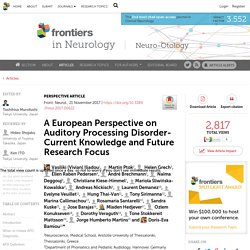
This hearing impairment, however, does not include the children and adult individuals who have normal hearing sensitivity but who experience auditory processing difficulties in everyday life that are reflected in reduced performance in other audiometric tests such as speech in noise or complex non-speech sound perception (3). This disorder is defined as “Auditory Processing Disorder” (APD) or “Central Auditory Processing Disorder” (CAPD) and is currently classified in ICD-10 as H93.25 for both acquired and congenital forms. The objective of the present paper is to define a baseline European APD consensus by experienced clinicians and researchers in this specific field of human auditory science. APD Definition 2. 5. Age, dyslexia subtype and comorbidity modulate rapid auditory processing in developmental dyslexia. Introduction Developmental Dyslexia (DD) is defined as a specific disability in learning to read adequately despite at least normal intelligence, adequate instruction and socio-cultural opportunities, and the absence of sensory defects in vision and hearing (American Psychiatric Association, 1994).

The prevailing views concerning the etiology of DD point to a deficit in encoding, representing and processing speech sounds (Snowling, 2001; Ramus et al., 2003; Ramus and Szenkovits, 2008). However, the question whether these difficulties reveal the core deficit of dyslexia or whether they are manifestations of a more general and basic auditory deficit is controversial. According to Tallal's (1980) hypothesis, children with DD would be impaired in their ability to perceive auditory stimuli that have short duration and occur in rapid succession.
A second controversy concerns the selectivity of the auditory processing deficit i.e., its being restricted to brief and rapidly presented stimuli. An Evidence-Based Perspective on “Misconceptions” Regarding Pediatric Auditory Processing Disorder. A Tutorial on Auditory Attention Identification Methods. 1.
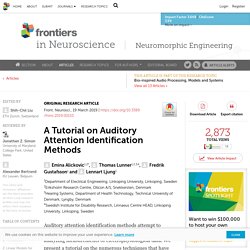
Introduction The first use of the term cocktail party in the context of auditory scene analysis appeared in Cherry (1953), where it was used to refer to the challenge of focusing on a single sound source, often a speech stream, while suppressing other unwanted sounds in a noisy and complex background. The ability to segregate and follow a sound source of interest in a cocktail party environment is one of the hallmarks of brain functions. Although this is a highly ill-posed problem in a mathematical sense, the human brain instantly solves this problem, with a compelling ease and accuracy that is difficult to be matched by any currently available algorithm.
However, recent studies have shown the potential of model-based algorithms to assist intelligent hearing aids, and the purpose of this tutorial is to provide a rather broad coverage of the mathematical tools available for solving the cocktail party problem. There are many studies on deciphering human auditory attention. 2. 2.1. End. Auditory training can improve working memory, attention, and communication in adverse conditions for adults with hearing loss.
Listening and Communication in Adverse Conditions It is widely accepted that understanding speech in background noise is the most common problem for people with hearing loss (Vermiglio et al., 2012; Humes et al., 2013), as characterized by the typical statement “I can hear but I cannot understand what is being said.”
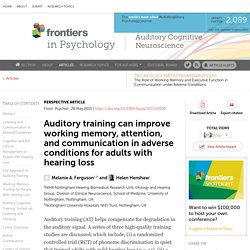
Basic auditory processing and sensitivity to prosodic structure in children with specific language impairments: a new look at a perceptual hypothesis. Introduction Specific language impairment (SLI) is a neurodevelopmental disorder of learning that affects the processing and production of spoken language (Leonard, 2014).
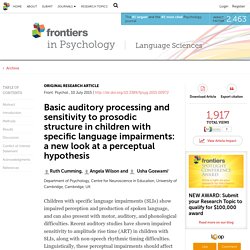
Children with SLI have no obvious hearing or neurological impairments, and no apparent prosocial difficulties, yet they fail to acquire language skills at an age-appropriate rate. A hallmark of SLI is grammatical difficulties, usually described as difficulties with morpho-syntax (see Leonard, 2014, for a recent overview).
For example, children with SLI will fail to use inflectional endings appropriately (“She comb her hair”), they will fail to mark tense (“Yesterday I fall down”), and they show poor understanding of syntactic devices like word order, selecting a picture of a fish eating a man for the sentence “The fish is eaten by the man” (see Hsu and Bishop, 2011). Auditory Processing after Early Left Hemisphere Injury: A Case Report. Introduction The patient was a 10-year-old male, who had a left hemorrhagic cerebral infarction secondary to arteriovenous malformation (AVM) at 13 months of age.
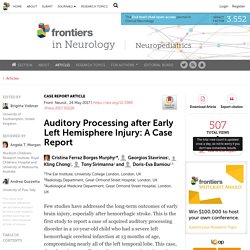
Because of his significant difficulty related to auditory perception, he was referred to the Audiological Medicine department at Great Ormond Street Hospital for Children to undergo hearing assessments, including auditory processing evaluation at the age of 10 years. His latest MRI (at age 11) showed, apart from the left craniectomy, an extensive mature injury in the left hemisphere mostly involving the left middle and posterior cerebral artery territories and nearly the entire left temporal lobe. There were less extensive mature regions of cortical injury in the right hemisphere, best seen in the right posterior sylvian cortex and right parietal cortex. Symmetrical mature injury of the cerebellar hemispheres was also noted (Figure 1). Figure 1. The scores obtained and the interpretation of results is demonstrated in Table 1. Assessing Auditory Processing Deficits in Tinnitus and Hearing Impaired Patients with the Auditory Behavior Questionnaire.
Introduction The auditory system transmits sounds from the environment to the auditory cortex where they are processed to produce a perception.
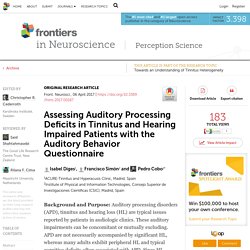
The sound signal, a vibroacoustic wave, is transduced into an electrical train of pulses at the synapses between the hair cells of the Corti organ and the auditory nerve. This interface is a powerful device able to transmit signals from the periphery to the auditory pathway spanning 12 decades in amplitude (120 dB) and 3 decades in frequency (20–20 kHz) (Knipper et al., 2013). This mechano-electrical transduction of sound waves into a train of electrical spikes is completed within 1–4 ms with standard deviation of roughly 0.8 ms, which is even lesser than the corresponding constant time of mammalian visual cells (Kopp-Scheinpflug and Tempel, 2015).
Auditory signals are thus reliably transmitted along large diameter axons and across highly specialized synapses through the afferent auditory pathway. Peripheral deficits afford HL or hypoacusis. Central plasticity and dysfunction elicited by aural deprivation in the critical period. The sense of hearing is a major pathway by which humans use to recognize environment.
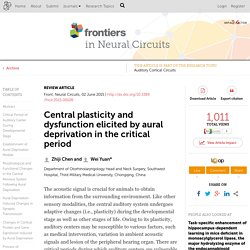
Acoustic cues assist humans to engage in neural activities integrated from multiple brain stations, which make constant adjustment of their behavior, such as learning, communication and exercise. Hearing impairment directly affects the recognition of language and social competency among humans. Hearing relies on the signal transmission from the auditory organ to the central auditory system. The central auditory system consists of cochlear nucleus, superior olive nucleus, lateral lemniscus, inferior colliculus, medial geniculation body and auditory cortex.
Earlier studies suggested connections between different stations of the auditory system which are structurally hard-wired. Plasticity is both structural and functional reorganization of the brain to adapt to ambient changes and physiological changes in the body (Jain et al., 1998; Rittenhouse et al., 1999; Pascual-Leone et al., 2005). Acknowledgments.
Early neural disruption and auditory processing outcomes in rodent models: implications for developmental language disability. Cluster Analyses Reveals Subgroups of Children With Suspected Auditory Processing Disorders. Introduction Some school-aged children appear to not hear well in difficult listening situations such as the classroom, in the absence of a hearing loss based on pure tone audiometry (Purdy et al., 2018).
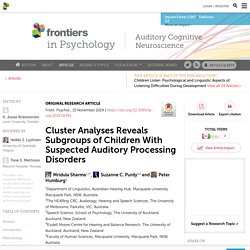
These children are often described as having problems hearing in noise, needing to have instructions repeated, being unable to follow verbal instructions and having generally poor listening skills (Chermak et al., 2002). Efficacy of Auditory Training in Elderly Subjects. Introduction The structural and functional changes in the auditory system due to aging can limit speech comprehension during difficult listening situations in elderly people (Corso, 1977; Jerger et al., 1989; Willott, 1991; Chisolm et al., 2003; Gates and Mills, 2005).
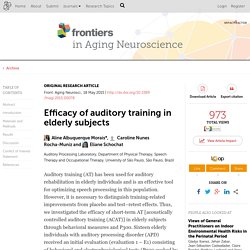
Previous studies have demonstrated poor performance of elderly people compared with young people during different auditory tasks, including temporal processing, listening in noisy environments, and dichotic listening, indicating that the difficulty in understanding speech among elderly people may be associated with auditory processing disorder (APD) (Dubno et al., 1984; Welsh et al., 1985; Jerger et al., 1989; Cooper and Gates, 1991; Snell, 1997; Phillips et al., 2000; Bellis and Wilber, 2001; Pichora-Fuller and Souza, 2003; Gates and Mills, 2005; Martin and Jerger, 2005; Kraus and Anderson, 2013). P300 is a long latency potential that occurs approximately 300 ms after a stimulus presentation. Materials and Methods Results. Predicting Future Reading Problems Based on Pre-reading Auditory Measures: A Longitudinal Study of Children with a Familial Risk of Dyslexia.
Introduction Dyslexia is a hereditary neurodevelopmental disorder characterized by persistent, lifelong reading, and/or spelling impairments that cannot be accounted for by low intelligence or environmental factors (Vellutino et al., 2004). Recent etiological views of dyslexia have proposed a multi-cognitive deficit model explaining the behavioral traits associated with this disorder (Pennington, 2006). It is theorized that multiple genetic or environmental factors act probabilistically as risk or protective factors. Thus, the interaction of these etiological factors result in the development of the specific cognitive risk or protective factors that increase or decrease the probability of the development of the expressed behavioral symptoms attributed to dyslexia.
Medial Efferent Mechanisms in Children with Auditory Processing Disorders. Department of Special Education and Communication Disorders, New Mexico State University, Las Cruces, NM, USA Auditory processing disorder (APD) affects about 2–5% of children. However, the nature of this disorder is poorly understood. Children with APD typically have difficulties in complex listening situations. One mechanism thought to aid in listening-in-noise is the medial olivocochlear (MOC) inhibition. The purpose of this review was to critically analyze the published data on MOC inhibition in children with APD to determine whether the MOC efferents are involved in these individuals.
The Age-Related Central Auditory Processing Disorder: Silent Impairment of the Cognitive Ear. Introduction Age-related hearing loss (ARHL), known as presbycusis as well, is a progressive disorder that affects hearing functions. The relationship of phonological ability, speech perception, and auditory perception in adults with dyslexia. 1Faculty of Psychology and Educational Sciences, Parenting and Special Education Research Unit, KU Leuven, Leuven, Belgium2Laboratory for Experimental ORL, Department of Neuroscience, KU Leuven, Leuven, Belgium This study investigated whether auditory, speech perception, and phonological skills are tightly interrelated or independently contributing to reading.
We assessed each of these three skills in 36 adults with a past diagnosis of dyslexia and 54 matched normal reading adults. Phonological skills were tested by the typical threefold tasks, i.e., rapid automatic naming, verbal short-term memory and phonological awareness. Dynamic auditory processing skills were assessed by means of a frequency modulation (FM) and an amplitude rise time (RT); an intensity discrimination task (ID) was included as a non-dynamic control task.
Speech perception was assessed by means of sentences and words-in-noise tasks. Received: 24 December 2013; Accepted: 15 June 2014; Published online: 02 July 2014. The Relationship between Types of Attention and Auditory Processing Skills: Reconsidering Auditory Processing Disorder Diagnosis.